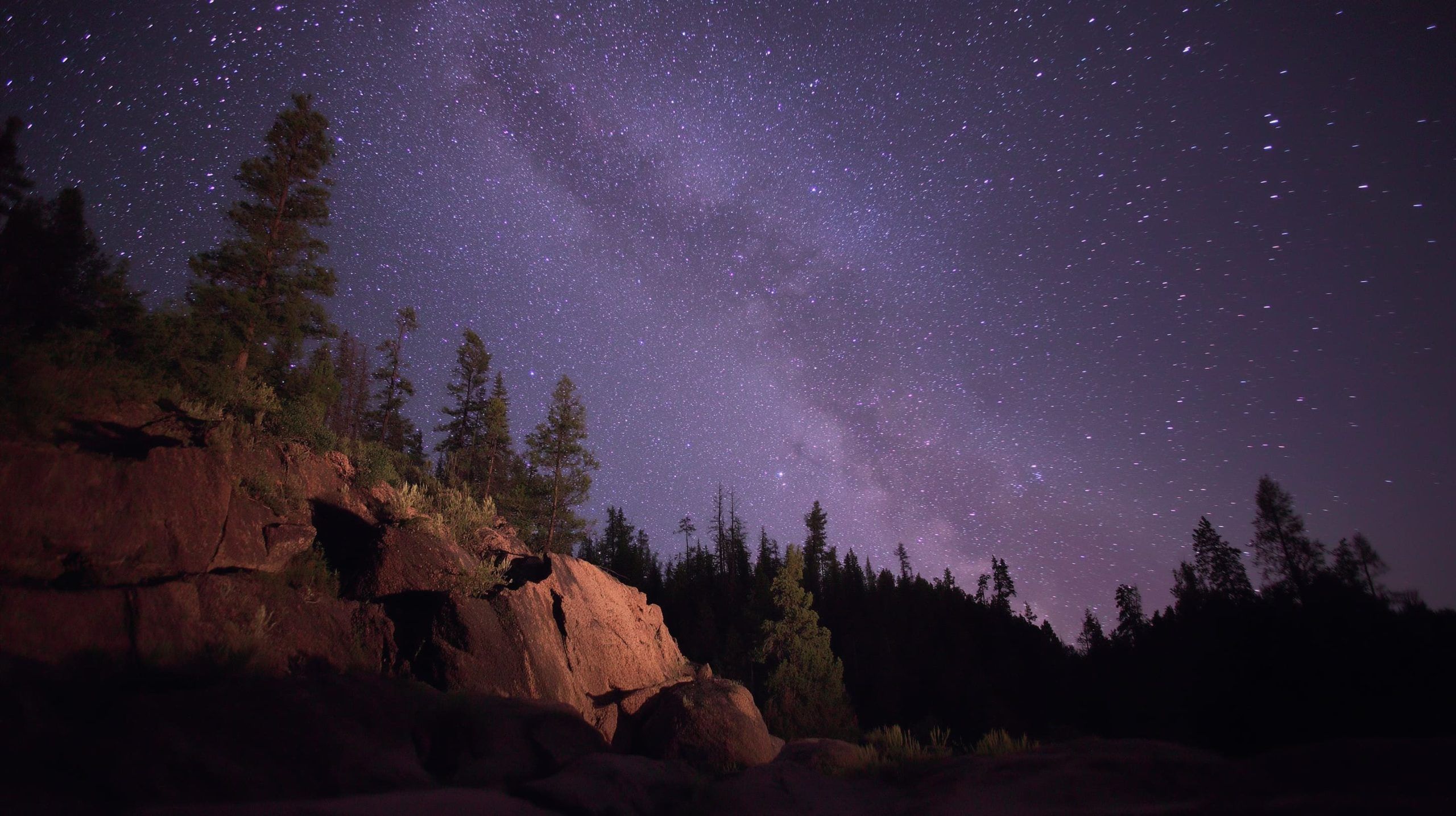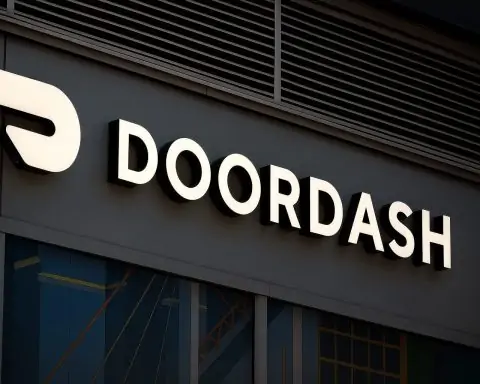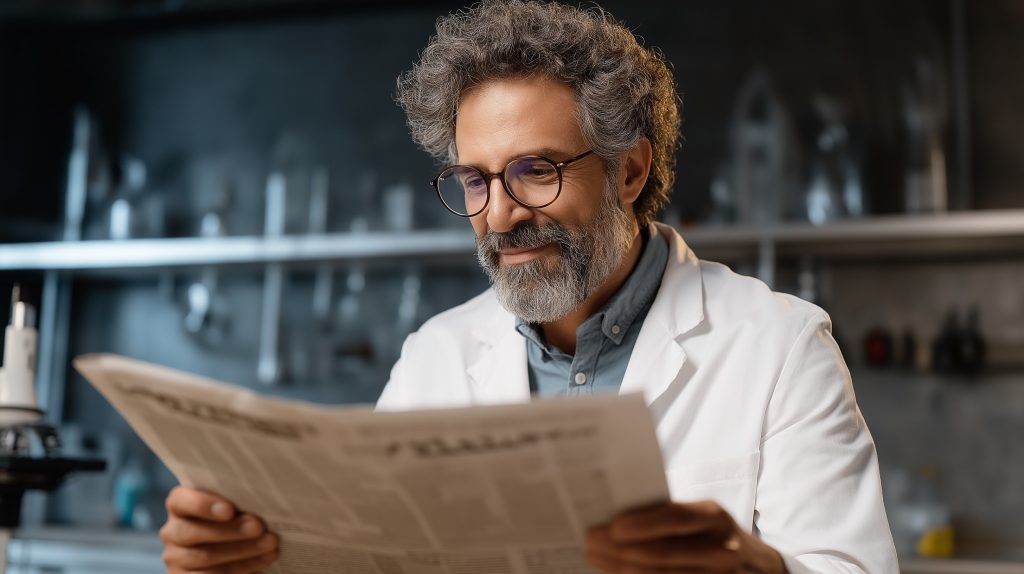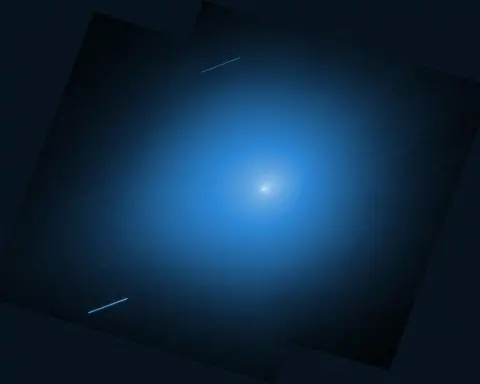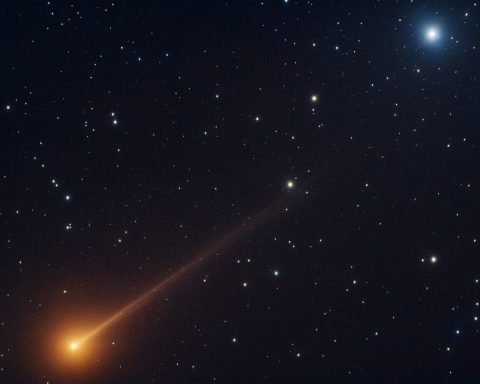- The Perseid meteor shower peaks August 12–13, 2025, delivering 60–90 meteors per hour under dark skies, though a bright 84% full Moon may limit visibility to about 15 meteors per hour.
- The Eta Eridanid meteor shower peaks in the pre-dawn hours of August 8, 2025, at about 3 meteors per hour and appears to emanate from the Eridanus constellation.
- The Southern Delta Aquariids remain active through late July into August, producing only a few meteors per hour.
- The Full Sturgeon Moon reaches peak illumination on August 9, 2025, turning full at 3:55 a.m. EDT and rising in the southeast around sunset.
- Saturn lies near the full Moon on August 9, 2025, with magnitude about 0.8 and a well‑tilted ring system, and Titan’s shadow on Saturn’s clouds crosses on August 3 and August 19.
- Venus and Jupiter form a close pre-dawn conjunction around August 11–12, 2025, separated by about 1° as they rise in the eastern sky roughly between 3:00 and 4:00 a.m.
- Mars is visible in the evening sky after sunset, but it is faint and very low on the horizon, sometimes requiring binoculars.
- All four naked-eye planets—Mars, Saturn, Jupiter, and Venus—can be spotted in one night around August 8–9, with Mars west after sunset, Saturn high late at night, and Jupiter and Venus in the east before sunrise.
- A CME around August 7–9 could trigger minor to moderate geomagnetic storms (G1–G2) with a chance of strong G3, potentially producing auroras visible as far south as Oregon, Illinois, Iowa, and New York.
- No eclipse occurs on August 8–9, 2025, but a total lunar eclipse will occur on September 7–8, 2025, lasting 82 minutes of totality and visible across Asia, Europe, Africa, Australia, and parts of the Americas.
Get ready for an unforgettable weekend of skywatching. On the nights of August 8–9, 2025, the heavens are putting on a show: one of summer’s most famous meteor showers is ramping up (despite interference from a bright full moon), the two brightest planets in our sky are drawing together in a dazzling pre-dawn conjunction, and even the northern lights might make a surprise appearance. Below is your complete guide – in plain English – to all the celestial and atmospheric phenomena to watch for during this exciting weekend.
Meteor Showers Light Up the Late Summer Sky
August is meteor season, and “meteor activity kicks into high gear in August as seen from the Northern Hemisphere,” notes the American Meteor Society [1]. The main reason is the Perseid meteor shower, one of the year’s most beloved meteor displays. The Perseids are active from mid-July to late August and normally produce a steady stream of shooting stars, building to a peak around August 12–13 [2]. Under ideal dark skies, the Perseids can deliver 60–90 meteors per hour at their peak. However, 2025 is not ideal – a bright moon will dramatically reduce the visible meteors. In fact, the Moon will be 84% full on the Perseids’ peak night, meaning only the brightest meteors will shine through [3]. The AMS estimates skywatchers might see only about 25% of the usual Perseid rates due to moonlight – roughly 15 meteors per hour at best around the peak [4]. Still, don’t count the Perseids out: this shower is famous for producing fireballs (exceptionally bright meteors) that can pierce even a moonlit sky [5]. A few bright Perseid streaks may be visible each hour in the late-night and pre-dawn hours throughout this weekend [6].
In addition to the Perseids, a couple of minor meteor showers are also active. The Southern Delta Aquariids, which peaked in late July, continue to send a few meteors from the south each night (just a few per hour) [7]. And on the night of Aug. 7–8, the Eta Eridanid meteor shower reaches its subtle peak. This is not a prolific shower – only on the order of ~3 meteors per hour – but it’s “worth watching for in the pre-dawn hours of Aug. 8, especially since it coincides with the active Perseids” [8]. Look toward the southeastern sky before dawn; the Eta Eridanids appear to emanate from the constellation Eridanus, which hangs low in the southeast [9].
Meteor Watching Tips: Because the Moon is very bright this weekend, try to observe meteors during the darkest hour before dawn, after the Moon has set (or is very low). Fortunately, on Aug. 8–9 the waning gibbous moon sets in the early morning hours, giving a brief window of darker skies before sunrise [10]. Find a safe, dark location away from city lights, get comfortable (bring a lawn chair or blanket), and simply look up – no telescopes or binoculars needed. Patience is key: allow at least 20–30 minutes for your eyes to adjust. Even with moonlight, you might catch a handful of Perseid “shooting stars” if you watch the sky long enough. As one expert puts it, the Perseid shower “remains above the level of the sporadic background for a week” around its peak [11], so any clear night in early August can yield some meteors. Keep an eye out for the brightest meteors – those are the ones that will stand out despite the moon’s glow [12].
The Full “Sturgeon Moon” Beams Brightly
Bathe in the light of August’s full moon this weekend. On the night of Saturday, August 9, the Moon reaches peak illumination as the Full Sturgeon Moon [13]. This full moon – named by Native American tribes for the sturgeon fish often caught in late summer [14] – will rise in the southeast around sunset and glow all night, putting on a spectacular lunar light show [15]. In fact, the Moon officially turns full on Aug. 9 at 3:55 a.m. EDT (07:55 GMT) [16], but it will appear fully bright both Friday and Saturday nights.
Be sure to watch the moonrise on Aug. 8–9 if you can. Around an hour after sunset, as the golden Moon is just lifting above the horizon, it can appear unusually large – an optical trick known as the “moon illusion” [17]. Seeing the huge orange globe of the moon creeping up behind trees or buildings is a breathtaking sight (and great for photographs). As the evening progresses, the Moon will climb higher and turn its usual pale white. Moonset comes in the west just around sunrise the next morning.
Notably, this weekend’s Moon will share the sky with Saturn. As the Sturgeon Moon rises on Aug. 9, look toward the east (to the Moon’s left or lower left) for a steady, golden point of light – that’s Saturn, just rising a short while after the Moon [18]. Saturn will be “nearby to the east” of the full Moon through the night [19]. Although they won’t be extremely close together, seeing the bright Moon and Saturn in the same general area of sky is a beautiful sight. Saturn itself is nearing its best viewing of the year (opposition is approaching), so it’s shining at a respectable magnitude ~0.8 – bright enough to spot with the naked eye despite the moonlight [20]. If you have a telescope, take a peek at Saturn: its rings are tilted nicely and even a small scope will reveal Saturn’s signature rings and maybe a few moons. In fact, Titan, Saturn’s largest moon, is casting its shadow on Saturn’s cloud tops twice this month (on Aug. 3 and Aug. 19) – a treat for advanced observers with telescopes [21] [22]. Fun fact: Because the Moon is full, it lies opposite the Sun in the sky – which means on Aug. 9 the Moon will be in the constellation Capricornus (right near Saturn in Aquarius). That’s why Saturn is so close to the full Moon this time around.
(No lunar eclipse occurs with this full Moon – it will shine unimpeded all night. The year’s next eclipse is a big one: a total lunar eclipse on September 7–8, 2025, when a dramatic “blood moon” will be visible across much of Asia, Europe, Africa, and Australia [23] [24]. More on that in the final section.)
Planets on Parade: A Dazzling Dawn Conjunction & Evening Sightings
Even aside from the Moon, planets are a major highlight of this weekend’s sky. August 2025 brings a celestial meet-up that you won’t want to miss: brilliant Venus and Jupiter – the two brightest planets – are converging for a close conjunction in the pre-dawn sky. They “shine brightly in the mornings” throughout early August and will “appear to graze each other in the sky” around August 11 and 12 [25]. In the early mornings of Aug. 11–13, Venus and Jupiter will be separated by only about 1° – roughly the width of your pinky finger held at arm’s length [26]! They’ll look like a stunning double planet low in the east before sunrise. By Aug. 11–12 (just a couple days after this weekend), the two planets will appear closest together – just a degree apart, nearly side by side [27]. But don’t wait until the last minute: if you’re up before dawn on Aug. 8–9, you can already catch Venus and Jupiter drawing near each other. Step outside around 3:00–4:00 a.m. local time: you’ll see Venus blazing like a diamond in the eastern sky (it’s currently the “Morning Star”, far brighter than any other star or planet). Jupiter will be just above or nearby, noticeably less bright than Venus but still one of the brightest objects in the sky [28]. Each morning, Jupiter creeps a little closer to Venus. It’s a fascinating sight to watch these planets “pair up” day by day [29]. They continue to rise higher until dawn’s light washes them out, so the best view is about 60–90 minutes before your local sunrise. (By the end of August, Mercury will join the morning lineup too, but it remains hidden in the Sun’s glare during this particular weekend [30] [31].)
What about the evening planets? As night falls on Aug. 8–9, look west where the Sun has set – Mars is out there, though it’s quite faint now (about as dim as the Big Dipper’s stars) and very low on the horizon after sunset [32]. You might need binoculars and an unobstructed view to glimpse Mars through the twilight glow. Saturn, however, comes to the rescue later at night: it rises in the east by around 10:00 p.m. in early August [33] and is visible for the rest of the night (as discussed, it’s near the full Moon on Aug. 9). Saturn will be highest in the sky toward dawn, ideal for telescope users. If you’re feeling ambitious, all four of the naked-eye planets (plus the Moon) can be spotted in one night: Mars low in the west just after sunset, Saturn arcing across the late-night sky, then Jupiter and Venus shining in the east before sunrise. It’s almost a mini “planet parade.” (With optical aid, you could even add Neptune and Uranus to the list: Neptune is sitting very close to Saturn this month – only about 1° apart, due to a rare Saturn–Neptune conjunction on Aug. 6 [34] – but Neptune is too dim to see without a telescope. Uranus rises in the early morning hours in Aries/Taurus, just below naked-eye visibility [35] [36].)
Looking ahead, a couple of neat planet+Moon pairings are coming soon: on Aug. 11, just after this weekend, the waning gibbous Moon will “tango” with Saturn in the late evening sky [37] (they’ll rise together around 11 p.m. local time and travel as a duo until dawn). And later in August, Mercury finally makes an appearance – reaching its greatest elongation from the Sun on Aug. 19 and becoming visible low in the dawn, joining Venus and Jupiter for a lovely triangular alignment just before sunrise [38]. But for now, during Aug. 8–9, the planetary stars of the show are unquestionably Venus & Jupiter at dawn and Saturn around midnight. Don’t forget to take a look at them – no telescope required, though binoculars will give Jupiter a tiny disk and maybe even reveal Venus’s phase (a gibbous shape) if steady enough [39] [40].
Aurora Alerts and Other Atmospheric Phenomena
As if meteors, planets, and a full moon weren’t enough, there’s also a buzz about auroras potentially gracing the skies this weekend. Heads up, aurora chasers! Space weather forecasters have flagged August 7–9 for possible geomagnetic storm activity that could trigger the Northern Lights much farther south than usual [41]. Here’s what’s going on: a recent coronal mass ejection (CME) – basically a burst of solar wind and magnetic energy from the Sun – is expected to deliver at least a glancing blow to Earth’s magnetic field around August 8 [42]. According to the U.S. National Oceanic and Atmospheric Administration’s Space Weather Prediction Center (NOAA SWPC), there is a chance of minor to moderate geomagnetic storms (G1 to G2) on Aug. 8, with even a slight chance of a strong G3 storm [43]. In tangible terms, NOAA’s forecast estimated the Kp index (a measure of geomagnetic activity) could reach 6 on the 0–9 scale – corresponding to a G2 moderate storm – during this period [44]. The U.K. Met Office similarly predicted unsettled magnetic conditions, noting the timing of the CME’s arrival is uncertain [45] [46].
What this means for skywatchers: if the forecast holds, auroras (Northern Lights) might be visible not only in the usual high-latitude locations (Alaska, Canada, Scandinavia, etc.) but also much farther south, possibly into the northern United States and middle Europe on the nights of Aug. 7–8 and/or Aug. 8–9. In fact, NOAA’s models indicated that up to 18 U.S. states could see the aurora if a G2 storm materializes, including states as far south as Oregon, Illinois, Iowa, and New York (in addition to the northern-tier states like Alaska, Montana, North Dakota, Michigan, etc.) [47] [48]. To have a chance, you’ll need to look north toward the horizon from a dark location – and weather permitting, you might notice a diffuse greenish glow or even faint rippling curtains of light. The best window for potential auroras, according to NOAA, was late Friday night (Aug. 7) through the pre-dawn hours of Saturday (Aug. 8) [49], roughly 11 p.m. to 5 a.m. EDT. However, the UK Met Office suggested the CME might arrive a bit later, possibly making Saturday night into Sunday morning (Aug. 8–9) the prime time [50]. Solar storms are famously hard to time exactly, so the prudent advice is: keep an eye on the sky both nights if you’re in a latitude that sometimes sees auroras. Even if a full-fledged aurora borealis display doesn’t pan out, the Moon-lit landscape under the Sturgeon Moon will be beautiful, and you might catch a faint green glow near the northern horizon if a minor storm is ongoing.
It’s worth noting that we’re currently near the peak of the 11-year solar cycle (Solar Cycle 25), so solar activity is high – meaning more frequent aurora alerts. This late summer period also marks the start of the “stronger-than-average northern lights season” at high latitudes as nights begin to lengthen [51]. So even beyond this weekend, aurora enthusiasts have reason to be excited in the coming months.
Other atmospheric lights: Another ethereal phenomenon to watch for, especially if you live in northern latitudes, is noctilucent clouds. These are the wispy, electric-blue “night-shining” clouds that occasionally glow low in the twilight sky on summer nights. The best time to spot noctilucent clouds is late May through mid-August, in the hour or two after sunset or before dawn [52]. By early August the season is winding down, but sightings are still possible. If you’re around 50–60°N latitude (for example, Canada, northern Europe, the northern U.S. states), keep an eye toward the northwest after dusk or northeast before dawn for delicate rippling tendrils of bluish-white light. These ghostly clouds form at the edge of space (~80 km up) and are illumined by the Sun from below the horizon, creating an otherworldly glow [53] [54]. They are rare and require a bit of luck, but if you see them, you’ll never forget it. (They look like glowing threads or wisps, distinct from the green of auroras or the white of ordinary clouds.) No special equipment needed – just your eyes and a clear, twilight sky.
No Eclipse This Weekend – But a “Blood Moon” is Coming
While no eclipse occurs on August 8–9, 2025, you haven’t missed out – the next major eclipse is just around the corner. Mark your calendar for September 7, 2025, when Earth will experience a total lunar eclipse visible across a huge swath of the globe [55]. During this event, the full Moon will pass completely into Earth’s shadow, turning into a deep coppery-red “Blood Moon” for 82 minutes of totality [56]. Skywatchers in Asia and Australia will get the best view of the entire eclipse from start to finish, but observers in Europe, Africa, and parts of the Americas will also catch at least some of the eclipse (including the breathtaking total phase, depending on local moonrise/moonset timing) [57] [58]. This Sept. 7–8, 2025 eclipse is noteworthy for being the longest total lunar eclipse since 2022, and about 7.1 billion people (nearly 88% of the world’s population) will have some view of it [59]. While that’s beyond the scope of this weekend’s skywatch, it’s an exciting event to look forward to next month – a reminder that the cosmos always has something spectacular on the horizon.
Weather permitting, the nights of August 8–9, 2025 promise a little something for everyone. Whether you’re marveling at the bright full Moon rising in the southeast, catching a wish on a Perseid meteor, admiring a brilliant planetary rendezvous before sunrise, or even chasing the aurora glow on the northern horizon, be sure to take some time to look up. Summer’s sky spectacle is in full swing – enjoy the show! 🌠🌕✨
Sources: NASA “What’s Up” skywatching bulletin [60] [61]; American Meteor Society (AMS) meteor forecasts [62] [63]; Travel + Leisure August sky guide [64] [65]; Space.com news on full moon and aurora forecasts [66] [67]; NOAA Space Weather Prediction Center [68]; EarthSky.org Perseid guide [69]; Space.com on noctilucent clouds [70]; and Space.com eclipse preview [71] [72].
References
1. www.amsmeteors.org, 2. earthsky.org, 3. science.nasa.gov, 4. earthsky.org, 5. www.travelandleisure.com, 6. science.nasa.gov, 7. www.amsmeteors.org, 8. www.travelandleisure.com, 9. www.travelandleisure.com, 10. www.amsmeteors.org, 11. www.amsmeteors.org, 12. www.travelandleisure.com, 13. www.space.com, 14. www.space.com, 15. www.space.com, 16. www.space.com, 17. www.travelandleisure.com, 18. www.travelandleisure.com, 19. www.travelandleisure.com, 20. starwalk.space, 21. www.astronomy.com, 22. www.astronomy.com, 23. www.space.com, 24. www.space.com, 25. science.nasa.gov, 26. www.travelandleisure.com, 27. science.nasa.gov, 28. science.nasa.gov, 29. www.travelandleisure.com, 30. starwalk.space, 31. starwalk.space, 32. science.nasa.gov, 33. science.nasa.gov, 34. www.astronomy.com, 35. starwalk.space, 36. starwalk.space, 37. www.travelandleisure.com, 38. www.travelandleisure.com, 39. starwalk.space, 40. starwalk.space, 41. www.space.com, 42. www.space.com, 43. www.space.com, 44. www.swpc.noaa.gov, 45. www.space.com, 46. www.space.com, 47. www.space.com, 48. www.space.com, 49. www.space.com, 50. www.space.com, 51. www.travelandleisure.com, 52. www.space.com, 53. www.space.com, 54. www.space.com, 55. www.space.com, 56. www.space.com, 57. www.space.com, 58. www.space.com, 59. www.space.com, 60. science.nasa.gov, 61. science.nasa.gov, 62. www.amsmeteors.org, 63. www.amsmeteors.org, 64. www.travelandleisure.com, 65. www.travelandleisure.com, 66. www.space.com, 67. www.space.com, 68. www.swpc.noaa.gov, 69. earthsky.org, 70. www.space.com, 71. www.space.com, 72. www.space.com
